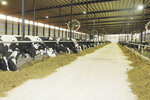

MADISON, Wis. — Many Americans turned their attention toward March Madness last month.
The U.S. dairy industry found itself in the throes of its own version of madness as cows on dairy farms in Texas and Kansas began exhibiting symptoms of an illness later identified as highly pathogenic avian influenza.
Dr. Keith Poulsen, director of the Wisconsin Veterinary Diagnostic Laboratory, spoke April 2 during a Professional Dairy Producer “The Dairy Signal.”
“The second week of March, farmers were dealing with an unknown morbidity event,” Poulsen said. “It was not acting like anything else we typically see on a dairy.”
As of April 9, the virus has been confirmed in 17 herds in six states: Texas, 9; Kansas, 3; New Mexico, 2; Idaho, 1; Michigan, 1; and Ohio, 1.
Farmers in the Texas panhandle began noticing a decrease in feed intake and reduced rumen motility as reported by rumination monitors. Cows suffering these symptoms were found to be second-lactation cows or older that were at least 150 days in milk.
The most unusual symptom was in the appearance of the milk of affected cows. While the cows did not have mastitis, the milk took on a colostrum-like consistency. When milk conductivity caused the affected cows to be pulled out for examination, fevers ranging from 103-106 degrees were noted.
Farms saw nearly 10% of their herds being affected, Poulsen said, causing a significant drop in overall production, with the production of affected cows dropping up to 30%.
The rate of incidence was fast, Poulsen said, with most cows exhibiting symptoms within four to six days of the initial cow. New cases in the herds typically tailed off by days 10-12.
As common ailments were ruled out, farmers and their teams of animal health specialists began searching to find answers.
Concurrently, the Minnesota Board of Animal Health announced March 20 that a young goat had tested positive for HPAI, the first instance of a U.S. domestic ruminant contracting the virus. That goat resided on a property where a backyard poultry flock had been depopulated due to HPAI in February. The goats and poultry shared access to the same water source.
Meanwhile, affected farms in the Southwest began reporting dead birds on their properties. Additional testing commenced March 22. The U.S. Department of Agriculture’s Animal and Plant Health Inspection Service issued a press release March 25 confirming that cows on dairies in Texas and Kansas had tested positive for HPAI.
Based on those tests, wild migratory birds were believed to be the source of the HPAI infection in dairy cattle.
“Cows aren’t dying,” Poulsen said. “We are not seeing the same thing we see in domesticated poultry. They are getting sick, decreasing in their milk production. Like any disease, though, as the affected cows have returned to milk, their lactation curves are typically muted.”
Poulsen said it is important to remember that so far, the incidence of disease is limited in the population of dairy cattle being affected.
“We don’t see it in transition cows or fresh heifers, replacement youngstock or steers,” Poulsen said. “We haven’t noted it in any of our beef or cow-calf populations in any state. So, what is different about those cows? Why are we seeing clinical signs in those cows that go off feed and drop in milk? That is yet to be determined. It is odd, because typically when you talk about disease incidence and prevention, we focus on transition cows and youngstock.”
The Centers for Disease Control and USDA continue to assure people the health risk to the general public remains low. However, the CDC confirmed April 1 that a dairy farm worker in Texas exhibited symptoms of conjunctivitis, testing positive for HPAI after having contact with infected cows.
Poulsen reiterated that the risk to public health is low.
“All dairy producers need to know this: All pasteurized milk and cooked meat are safe for consumption,” Poulsen said. “There is no reason for the consuming public not to trust the safety and wholesomeness of their food supply.”
Poulsen said that the biology of this strain of influenza is not new.
“This is the circulating strain of influenza we watched in Europe in early 2020,” he said. “In 2022, it made its way through the migratory bird population through North America, down into South America and back. We’re still seeing this in our wildlife population. So far, it’s been the worst foreign animal disease in U.S. history, because we have depopulated close to 100 million birds.”
This is not the first time mammals have been affected by HPAI. Over 130 different mammalian species have been affected.
“Most of our affected mammalian species are what we consider mesocarnivores, or scavenging carnivores,” Poulsen said. “They are eating dead birds, animals like cats and some hunting dogs in Nebraska. Right now, we’re talking about affected sea mammal populations that are scavenging dead birds in Washington. It’s a little different than our ruminant species; this is a new manifestation of the virus.”
Poulsen said the question to be answered is how the cows became affected and how the virus is transmitted.
“Cows don’t scavenge dead birds; they are herbivores,” Poulsen said. “It made us wonder if birds were the primary source. The topography in the panhandle of Texas is quite different than Wisconsin. It’s a desert, and the water sources are often shared by migratory birds.”
Following the movement of lactating dairy cattle from Texas and Kansas to herds in Michigan and Idaho, cow-to-cow transmission was noted.
“We’re still working (on) how that happened,” Poulsen said. “We know testing milk samples is a good way to identify it. We’re looking at if it could have been manure or urine, but the jury is still out. In people, we tend to spread flu by aerosolization or coughing, but we know most animals don’t have respiratory disease.”
Poulsen said that in Wisconsin, migratory bird populations are monitored. The virus has been detected both last fall and this spring. He said that the virus is referred to as an enveloped ribonucleic acid virus, meaning it thrives in cold, wet weather.
The warm, dry weather in February and early March caused most of the migratory birds to move through the area quickly, although the migration is not yet over.
“Last fall was different,” Poulsen said. “It was warm, and due to the drought, the harvest was late. So, we saw migratory birds staying and comingling, because there was a lot of food available for them. We saw domestic poultry affected last fall, and we just finished the cleaning and sanitation earlier this year.”
As of April 2, Poulsen confirmed that no known cases of HPAI are present in Wisconsin. He urged farmers to be vigilant and bring concerns to their herd veterinarians immediately.
“If you see animals that present the symptoms of decreased feed intake and rumination, production drops, change in the appearance of milk or fevers, contact your veterinarian,” Poulsen said. “Those animals can be reviewed to see if they meet the criteria for testing.”
Poulsen said if a farm has animals that meet the case definition, the USDA will pay for testing up to 20 animals. That testing can be done by any accredited veterinarian.
“While HPAI is reportable, in Wisconsin and many other states, it is not actionable,” Poulsen said. “We shouldn’t be concerned about any quarantine, control zones or depopulation on these farms at this time. There is no indication for that at this time.”
Implementing biosecurity plays a vital role in protecting a dairy farm, Poulsen said.
“Many dairy producers ship calves to warm, dry climates because it is more efficient and cost-effective for health and productivity reasons,” Poulsen said. “We move cattle all over the country to be more efficient. That does institute risk, but we have a significant infrastructure to diagnose and manage that risk. It’s not perfect, but it is pretty good.”
Poulsen recommends dairy farmers use the American Association of Bovine Practitioner’s guidelines for implementing biosecurity measures. That includes simple measures such as boot washes and increased sanitation. Others, such as quarantining new animals on the farm for 14-21 days, can be challenging.
“That is really hard to do on dairies, having facilities dedicated only to quarantining animals,” Poulsen said. “Dairy farmers should ask their veterinarians to go through those biosecurity protocols with them to see what they can do to safeguard and mitigate risk for any disease. Some things are going to be long-term plans. We need to think of the return on investment and the cost for biosecurity essentially as an insurance plan.”
Comments
No comments on this item Please log in to comment by clicking here